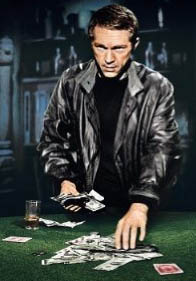|

Join our Newsletter
& get our free guide Starting Hands Revealed
We hate spam too!
We value your privacy and never share your email. All our emails have an opt-out link. Click it, and you will never hear from us again. |
Check Raising in Poker
In no-limit holdem, the check-raise is a very powerful move with a high dose of deception, the favorite weapon of poker players. First the villain shows weakness when checking, then he shows strength by raising. So is it a truly strong hand used to set up a trap, or is it a hand that missed the flop and wants to scare you away? Note that check-raising in fixed limit holdem has much less effect as calling the raise only requires one more bet, whereas in no-limit if you had raised for the value of the pot and got min-check-raised, you must invest one more time an amount equal to the pot just to stay in the hand. The check-raise in no-limit hold'emIn mid-stakes holdem and using our database which contains 220 holdem regulars from PokerStars, we find that the check raise frequency (crf) ranges between 0 and 20%, with an average value of 4.6% and a standard deviation of 2.8%. This is a very useful statistic if you play against someone for whom you have historical data. Any player with a crf below 2% must be taken seriously when he check raises you. Conversely you must discount a large chance of bluffing or semi-bluffing when your opponent has crf≥9%. Check-raising should be perpetrated infrequently, otherwise it projects an overly bluffing and aggressive image which can be exploited by folding less, and calling or 3-betting more. There are many possible reasons or situations where you can or should check-raise. A classic case is to protect big hands versus draws. If you play against a relatively aggressive player who raised preflop, and who has a high c-bet frequency. For instance you limped with 6♦6♥ from MP1, the CO raised to 4bb, the blinds fold, you called, and the flop is A♣Q♣6♠. You are certain that villain will bet, but you are also nearly certain that if you bet first, he will fold often given your image. Incidentally there is a flush draw on the board. The standard play is to check raise 3 times, so as the pot was 9.5bb, if he bets 7bb, you raise 21bb, making the pot 51.5bb after his call if he does. This is close to committing and if he called you are against a draw or a better set most of the time. Another situation is to check raise with your draws. In the previous situation if your hole cards were J♣T♣ instead of 6♦6♥, you now have a gut shot straight flush draw with 46.67% chance to hit by the river. You hope for an immediate fold but if the villain calls you, you have 12 outs. Another case where you may use the check-raise weapon is to ascertain where you are at in some less clear situations. Say you have A♦8♠ in the big blind, everyone folds to the button who make a standard 3bb raise, the small blind folds and you call because the button has a very high stealing frequency. The flop is A♥T ♣3♠, you check, the button makes a standard c-bet of 5bb, you min-raise to 10bb. If the button missed the flop he will normally fold, otherwise you know that you are probably against a hand that beats you. The extra 5bb that you have invested now could be cheaper than calling two more bets to the river with TPNK. Check-raising may somehow reverse your positional disadvantage. For instance very often in a heads up situation both players missed the flop. The hero plays first and checks, the villain bets and the hero must fold as he has nothing and he does not know if the villain has a hand or if he is just using his position to make hero fold. Check-raising reverses this scenario as now the heat is on the villain. You can employ this technique for example if you have a low pair on an unthreatening board with no ace if you suspect that villain has AK. This again let you know where you stand. Check-raising is a multi-edged sword. You can use it to increase your chip taking and to instill fear in your opponents. The message that you want to convey is that if you check, it does not mean that the pot is up for grabs. If you check-raise a few times with strong hands, your observant opponents will remember and they will not be as easily tempted to steal the pot from you in the future when you check. |









